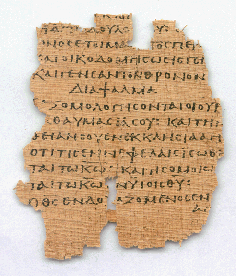ANCIENT SOCIETY 36 (2006)

Ancient Society
Festschrift Léon Mooren
Volume 36
2006
Selections from the Table of Contents
1 - 11 -
A Demotic Lease of Temple Land Reused in the Katochoi Archive (Louvre N 2328A)
CLARYSSE, W. & VANDORPE, K.
Abstract :
The katochoi of the Memphite Serapeum often reused the empty
spaces of demotic contracts for writing private documents such as
accounts, drafts of petitions and even literary texts. One such text is a list
of Macedonian months written in the margin of an old demotic lease of
temple land, dated to 215/214 BC. Three persons sublet to two others a
substantial area of land for which the rent has to be paid to the temple of
the god Horus of Buto. At least two of the persons involved have Greek
names and a third is a «Greek born in Egypt». One of the neighbouring
plots belonged to «the troop of the Greeks in Egypt». These Greeks, like
the katochoi half a century later, were clearly at home in two worlds.
13 - 44 -
Hunger, Not und Macht
Bemerkungen zur herrschenden Gesellshaft im ptolemäischen Ägypten
HEINEN, H.
Abstract :
An den Themen Hunger, Not und Macht können typische
Züge der herrschenden Gesellschaft des ptolemäischen Ägypten aufgezeigt
werden. Zwei Ehrendekrete stehen im Mittelpunkt dieses Aufsatzes:
das Kanopos-Dekret der ägyptischen Priester für Ptolemaios
III. und seine Gemahlin aus dem Jahre 238 v.Chr. (OGIS I 56; Bernand,
Prose I 9) sowie das thebanische Ehrendekret für den Strategos
Kallimachos von ca. 39 v.Chr. (OGIS I 194; Bernand, Prose I 46). In
beiden Fällen entscheiden die einheimischen Priester über Auswahl,
Definition und Belobigung herrschaftlicher Leistungen. Wenngleich
Sprache, Stil und Aufbau der beiden griechischen Texte sich an der
Form hellenistischer Ehrendekrete orientieren, so sind doch wesentliche
Inhalte deutlich durch ägyptischen Kult und Traditionen geprägt.
Daraus lassen sich Schlüsse auf die bemerkenswerte Position der ägyptischen
Priester innerhalb der ptolemäischen Eliten ziehen. Keine
andere hellenistische Monarchie kennt eine vergleichbare Situation.
Die detaillierte Interpretation des Ehrendekrets für Kallimachos führt
im Übrigen zu Ergebnissen, die sich in wichtigen Aspekten von dem
Bild unterscheiden, das ein Großteil der Forschung von der Stellung
dieses Mannes gezeichnet hat.
45 - 49 -
Ptolemaios V. als Harpokrates?
HUSS, W.
Abstract :
ln der vor wenigen Jahren von Renate Thomas publizierten, in
Privatbesitz befindlichen Statuette ist wahrscheinlich nicht Dionysos/Ptolemaios
IV., sondern Harpokrates/Ptolemaios V. zu sehen. Der antike
Auftraggeber der Statuette scheint in der Zeit um 200 v.Chr. im privaten
Bereich einen Gedanken nachvollzogen zu haben, den die offizielle Propaganda
vorgegeben hatte: Ptolemaios V. als Garant der Prosperität!
175 - 219 -
Kriton, stolarque au service d'Apollonios le diœcète
HAUBEN, H.
Abstract :
No less than 47 documents in the Zenon archive mention the
name Kriton. In Clarysse’s standard prosopography 34 are listed as
referring to the so-called stolarches of the dioecetes Apollonios, minister
for economic and financial affairs of Ptolemy II (285/282-246
BC) during the second half of his reign, and one of the wealthiest entrepreneurs
of his time.
The present article focuses on both the meaning of the term stolarches
(which occurs only once in the archive, viz, in P. Cairo Zen. I 59048)
and the manifold tasks, specific profile and individual career of
Kriton.
An exhaustive analysis of the Hellenistic and Roman literary, epigraphical
and papyrological sources seems to confirm the traditional
view that the stolarchia involved a (military or commercial) fleet command,
rather than a control of clothing or responsibility for equipment,
as claimed by more recent interpretations.
As commander of Apollonios’ small flotilla (obviously in charge of the
organization of river — not overseas — transport and communications)
Kriton was one of his most trusted employees as well as perhaps the
closest collaborator of the minister’s secretary (subsequently estate
manager) Zenon, especially in the years 258-256 BC, when Apollonios
and his staff were travelling around in Northern Egypt.
A study of the papyri not belonging to the core dossier of 34 texts leads
to the conclusion that, with the exception of two (PSI V 495 l. 7 and
P. Cairo Zen. III 59462), all the references to Kriton may probably
also be ascribed to the (ex-)stolarches, who, after the accession of
Ptolemy III (246) and the subsequent disappearance of the minister in
245, seems to have established himself (like his friend and former colleague
Zenon had done after his dismissal in 248/247) in the region of
Philadelphia in the Fayum, making a living from his vineyard, his ship
and other business.
221 - 238 -
The Ethics and Economics of Ptolemaic Religious Associations
MONSON, A.
Abstract :
This paper considers the economic status of the members
in Ptolemaic religious associations and offers a model to explain why
they participated. Drawing on Charles Tilly’s comparative study of
trust networks, I suggest that religious associations institutionalized
informal ethical norms into formal rules that lowered the costs of
transacting and facilitated cooperation among villagers. The rules
related to legal disputes illustrate how associations exercised this
power and even tried to prevent the Ptolemaic state from intruding in
their network.
Source: Petters online Journals
Labels: Ancient Society















